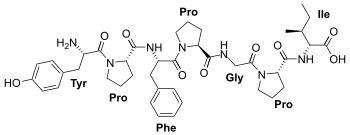Casomorphin

Casomorphin is an opioid[1][2] peptide (protein fragment) derived from the digestion of the milk protein casein.[3]
Health
Digestive enzymes can break casein down into peptides that have some biological activity in cells and in laboratory animals though conclusive causal effects on humans have not been established.[3] Although they have not yet been proven to be formed in the human digestive system,[4] there are associations between serum levels of β-casomorphins and the risk of sudden infant death syndrome,[1] histamine release,[2] stimulation of food intake, specifically high-fat foods,[5] and lymphocytosis.[6]
Although research has shown high rates of use of complementary and alternative therapies for children with autism, including gluten and/or casein exclusion diets, as of 2008 there was a lack of evidence that these diets had any effect.[7]
List of known casomorphins (non-exhaustive)
β-Casomorphins 1–3
- Structure: H-Tyr-Pro-Phe-OH
- Chemical formula: C23H27N3O5
- Molecular weight: 425.48 g/mol
Bovine β-casomorphins 1–4
- Structure: H-Tyr-Pro-Phe-Pro-OH
- Chemical formula: C28H35N4O6
- Molecular weight: 522.61 g/mol
Bovine β-casomorphin 1–4, amide
- Structure: H-Tyr-Pro-Phe-Pro-NH2
- Chemical formula: C28H35N5O5
- Molecular weight: 521.6 g/mol
Also known as morphiceptin
Bovine β-casomorphin 5
- Structure: H-Tyr-Pro-Phe-Pro-Gly-OH
- Chemical formula: C30H37N5O7
- Molecular weight: 594.66 g/mol
Bovine β-casomorphin 7
- Structure: H-Tyr-Pro-Phe-Pro-Gly-Pro-Ile-OH
- Chemical formula: C41H55N7O9
- Molecular weight: 789.9 g/mol
Bovine β-casomorphin 8
- Structure: H-Tyr-Pro-Phe-Pro-Gly-Pro-Ile-Pro-OH
- Chemical formula: C46H62N8O10
- Molecular weight: 887.00 g/mol
(Note: There is also a form of bovine β-casomorphin 8 that has histidine instead of proline in position 8, depending on whether it is derived from A1 or A2 beta-casein.)
References
- 1 2 Wasilewska, J; Sienkiewicz-Szłapka, E; Kuźbida, E; Jarmołowska, B; Kaczmarski, M; Kostyra, E (2011). "The exogenous opioid peptides and DPPIV serum activity in infants with apnoea expressed as apparent life threatening events (ALTE)". Neuropeptides. 45 (3): 189–95. doi:10.1016/j.npep.2011.01.005.
- 1 2 Kurek, M; Przybilla, B; Hermann, K; Ring, J (1992). "A naturally occurring opioid peptide from cow's milk, beta-casomorphine-7, is a direct histamine releaser in man". Int Arch Allergy Immunol. 97 (2): 115–20. doi:10.1159/000236106.
- 1 2 European Food Safety Authority. 1 February 2009 Review of the potential health impact of β-casomorphins and related peptides
- ↑ Clemens, RA (2011). "Milk A1 and A2 peptides and diabetes" (PDF). Nestle Nutr Workshop Ser Pediatr Program. 67: 187–95. doi:10.1159/000325584. PMID 21335999.
- ↑ Lin, L; Umahara, M; York, DA; Bray, GA (1998). "Beta-casomorphins stimulate and enterostatin inhibits the intake of dietary fat in rats". Peptides. 19 (2): 325–331. doi:10.1016/S0196-9781(97)00307-0.
- ↑ Kayser, H; Meisel, H (1996). "Stimulation of human peripheral blood lymphocytes by bioactive peptides derived from bovine milk proteins". FEBS Lett. 383 (1–2): 18–20. doi:10.1016/0014-5793(96)00207-4.
- ↑ Millward, C; Ferriter, M; Calver, S; Connell-Jones, G (2008). "Gluten- and casein-free diets for autistic spectrum disorder". Cochrane Database of Systematic Reviews (2): CD003498. doi:10.1002/14651858.CD003498.pub3. PMC 4164915. PMID 18425890.